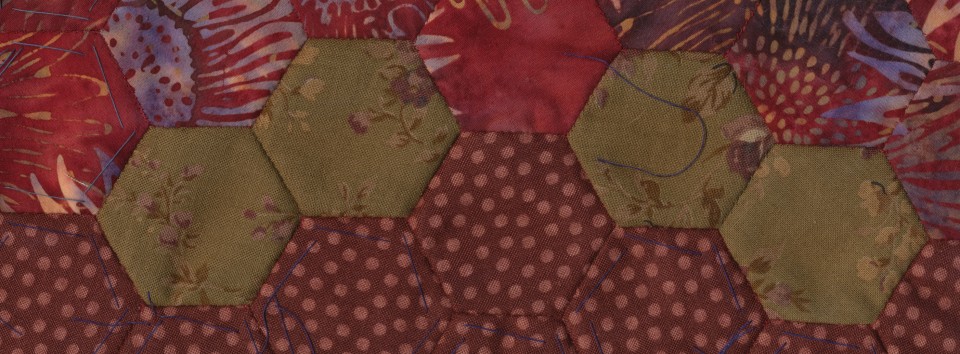I posted last week about Table Runner Number Two and Louise commented that she has finished some hexie borders by cutting off excess portions of hexagons after sewing on the border. She suggested that this might be easier than using half hexagons. I decided to give this a try on my latest table runner instead of doing the half hexagon border I had planned.
My main concern in doing the border in this manner regards the stability of the hexagon seams on the outer border after the seams are cut in half. I realize that the machine application of the border to the front of the quilt top would serve to stabilize the seams like it does with machine seams of traditional piece work. However, machine seams are more stable in themselves because they are composed of two threads which are interlocked. Perhaps one row of stitching is enough to hold them in place.
My other concern was cutting the excess accurately. Should I use a rotary cutter, or should I use a pair of scissors? I was afraid to use a rotary cutter because there was just too much potential to get confused and make a slice I would regret.
I decided to kill two birds by starting out with a contrasting color of stitching on the pieced top that would show where I would ultimately cut the border in half and stabilize the seams at the same time. I’m glad I decided to do this because it pointed out to me exactly how easy it would have been to make a mistake in my cutting without some additional guidance. The straight areas were easy to sew, but I sewed both angled areas incorrectly the first time I sewed them. See below.
I Had to rip out the excess stitching on the two angles that form the center of the piece because that stitching would have shown if I had left it in place. I was able to fix the eight other angles by adding extra stitching where it belonged.
After sewing with the contrasting thread I decided to sew with my green thread just inside the contrasting line to provide even more stability for the seams after they were cut.
I then got the piece ready to baste.
I use a method of basting that tailors use. You can see it here.
To provide even more stability for the seams on the border, and to make trimming the excess fabric easier, I stitched along the inside with green one more time after basting the quilt. This joined all three layers together.
I quilted the piece before trimming away the excess on the borders. I decided to trim using scissors, and to trim outside of the contrasting thread line to preserve this row of stitching as a stabilizing element in the border.
I used a utility quilting method applying straight lines of stitching through the center of alternate rows of hexagons in all three directions. This results in a triangular quilting pattern.
I still need to bind this piece, but I need to order some more hunter green fabric in order to do so. I’ll be ordering enough for the Diamond Quilt backing while I am at it. After I complete the binding I will be able to see what a half hexagon border will look like on my Diamond Quilt regardless of how I choose to achieve that border.
My gut feeling about the Diamond Quilt is that I should not use this method for the border. I still worry about the stability of the cut seams even though I provided four new stabilizing rows of stitches to hold those seams in place. That is probably more than enough for a table runner that won’t see the inside of a washing machine very often. However, a quilt that is going to get a lot of wear, and many washings should have seams that are stabilized with knots so they can’t come undone. The Diamond Quilt is going to be an heirloom quilt. As such, it deserves to have the extra time invested in doing the border with half hexagons rather than slicing full hexagons in half and leaving a vulnerability in the construction.
If I was going to make a 3/4 inch hexagon quilt, or a 1/2 inch hexagon quilt I might press the hexagons in half and use a border wide enough to cover the excess., but I don’t think I would cut away the excess on a bed quilt.
Does anyone think I am being too conservative?
















































